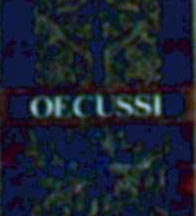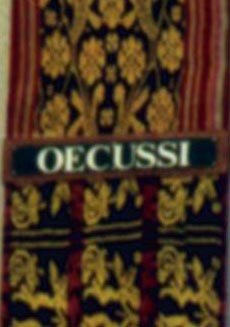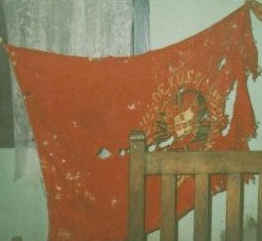 zachary harden
zachary harden
Keywords: oecussi ambeno | coat of arms | oé-cussi | micronation | quatair / ocussi ambeno | madagascar | imaginary | hoax |
Links: FOTW homepage | search | disclaimer and copyright | write us | mirrors

Last modified: 2023-06-10 by  zachary harden
zachary harden
Keywords: oecussi ambeno | coat of arms | oé-cussi | micronation | quatair / ocussi ambeno | madagascar | imaginary | hoax |
Links: FOTW homepage |
search |
disclaimer and copyright |
write us |
mirrors
Oecussi Ambeno never had separate administration from East Timor.
Mikhail Revnivtsev, 06 August 2005
Oecusi-Ambeno is part of East Timor and will be a part
of independent Timor Lorosae. There’s no question about that.
Jorge Candeias, 25 February 2000
Soon after WWII Indonesia got independent
and East Timor was subject to an agreement between Indonesia
and Portugal, by which Indonesia recognized the sovereignty
of Portugal over the territory and guaranteed that it didn’t
have any territorial ambitions over any part of the territory.
The territory was defined as the
Portuguese possessions
before the war: the eastern part of the island of Timor, the
island of Atauro to the north, the small island of Jaco off
the eastern tip of Timor and the enclave of Oecussi Ambeno in
the eastern half of Timor. Even after the invasion, Indonesia
maintained these territories together and separated from the
rest of the country as the province of Timor
Timur. The legal status of the territory is, therefore,
perfectly clear: it’s a part of East Timor, and has been so
since before WWII.
Jorge Candeias, 08 October 1999
The enclave is part of East Timor and will join the newly independent
country. The territorial make up of East Timor was never a debate issue,
rather only its status (either Indonesian province or occupied Portuguese
territory under a decolonization and independence process). Indonesian
occupation officials (unlike others in similar circumstances) did not change the
borderlines fixed in 1912 between Portugal and the Netherlands, and UN-sponsored
independence referendum was held in the territory.
Antonio Martins, 08 October 1999
On the right and the left wall of the East Timor national parliament
are hanging traditional weavings, each with the name of one of the
districts. Each district has such a weaving
on the left and the right, but
there are not exactly the same, just similar.
J. Patrick Fischer, 08 August 2002
 image by J. Patrick Fischer, 08 August 2002
image by J. Patrick Fischer, 08 August 2002
 image by J. Patrick Fischer, 08 August 2002
image by J. Patrick Fischer, 08 August 2002
Some, not all, Portuguese overseas municipalities received arms and
flag in the period 1940-1974, after all metropolitan
municipalities got one. In Portuguese Timor overseas province only
Díli had a flag and a coat of arms, all other
12 municipalities (currently named districts)
being confirmedly flagless.
António Martins, 15 January 2003 and 06 August 2005
 image located by
Francisco Santos, 26 May 2003
image located by
Francisco Santos, 26 May 2003
Originally on line,
this seems to be a Portuguese
colonial or Army flag.
Several months ago I contacted the association that runs the site
(Associação dos Militares do Oé-Cussi, Former Portuguese
Military Serving in Oecussi Association), to get information about this flag,
but I got no answer. It seems that this photo was taken in 1999. It is written
that the former chieftain of Oecussi, D. José Hermenegildo da Costa, kept
the flag with the will to hoist it the day the Indonesians would leave
Timor-Leste. However, D. José was deported to Kupang, Indonesia and passed
away on November 4, 1999.
Francisco Santos, 26 May 2003
This is the flag of H.R.H. the late (assassinated) Liurai, Don Jose
Hermenegildo da Costa, he reigned from before 1972 to Dec. 1999. The flag is
similar to the Port. flag, but all in red, with the Portuguese arms overall in
the centre, over the top are the words, "DE YUSSIF"(?) at the sides is a wreath
of leaves, tied with a ribbon in the base, all in yellow or gold. The
inscription is in Portuguese and I think the flag was captured? in 4 Nov, 1999
Source:
http://oecussi.no.sapo.pt/regulo.htm
John McMeekin, 6 September
2011
A "liurai" is a traditional king on Timor island. The Costas are a mixed
Portuguese/Timorese family, which have ruled Oecusse for several hundred years.
José Hermenegildo da Costa ruled from 1949 to 1999, together with João
Hermenegildo da Costa (1948-1990). The current liurai is António da Costa.
Portugal gave flags to liurai as symbol of their loyalty, which were kept as
holy items (lulik).
J. Patrick Fischer, 8 September 2011
Generally, Portuguese gave national flags to the Timorese kings (liurai) in a
ceremony, together with a military title, according to their status (colonel for
example). When Portugal became a republic, governor Alfredo Augusto Soveral
Martins lowered the blue-white royal flag and raised the new green-red flag of
the republic on 30th October 1910 with 21 gunshots of salute. But the kings got
their power out of their holy items (lulik). The blue-white flag, which was
given as gift, represented the old powerful Portugal and alienated this power to
the Timorese king. The changing of flags resulted into a lost of power in the
eyes of the Timorese. This was one of the reason for the biggest uprising in
Timor against Portugal ever, which occurred between 1911 and 1912.
J.
Patrick Fischer, 12 September 2011
I'd say this flag started out as a red field with a green hoist layered
over it. For some reason most of the green is gone. The wreath and lettering run
all around the sphere, and the lettering seems to be written for left-hoist. I
take it that it is the name of the kingdom, even if it seems to differ from what is
written in the title of this message.
Peter Hans van den Muijzenberg,
13 September 2011